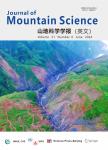Environmental Factors that Affect Primary Plant Succession Trajectories on Lahars(Popocatépetl Volcano,Mexico)
Environmental Factors that Affect Primary Plant Succession Trajectories on Lahars(Popocatépetl Volcano, Mexico)作者机构:Departamento de Geografía FísicaInstituto de GeografíaUniversidad Nacional Autónoma de México.Circuitoexterior s/nCiudad Universitaria04510 MexicoDistrito FederalMexico Laboratorio de Análisis GeoespacialInstituto de GeografíaUniversidad Nacional Autónoma de México.Circuitoexterior s/nCiudad Universitaria04510 MexicoDistrito FederalMexico Departamento de A.G.R.y Geografía FísicaFacultad de Geografía e HistoriaUniversidad Complutense de Madrid.Calle Profesor Aranguren s/nCiudad Universitaria28040MadridSpain
出 版 物:《Journal of Mountain Science》 (山地科学学报(英文))
年 卷 期:2015年第12卷第5期
页 面:1254-1266页
核心收录:
学科分类:0709[理学-地质学] 0819[工学-矿业工程] 08[工学] 09[农学] 0303[法学-社会学] 083305[工学-城乡生态环境与基础设施规划] 0708[理学-地球物理学] 0818[工学-地质资源与地质工程] 0903[农学-农业资源与环境] 0705[理学-地理学] 0815[工学-水利工程] 0706[理学-大气科学] 0816[工学-测绘科学与技术] 0813[工学-建筑学] 0704[理学-天文学] 0833[工学-城乡规划学] 0713[理学-生态学] 0834[工学-风景园林学(可授工学、农学学位)]
基 金:supported by National Autonomous University of Mexico(DGAPAPAPIIT,Research Proyect-IN301414) Ministerio de Educación y Ciencia,Espana(Research Proyect CGL2006-01983/BTE) Ministerio de Ciencia e Innovación,Espana(Research Proyect CGL200907434) Ministerio de Economía y Competitividad,Espana(Research Project CGL2012-35858)
主 题:Ecosystem regeneration Plantcolonization Primary succession Temperate forest Light exposure Elevation Soil Slope aspect
摘 要:The earliest stages of plant succession on severely disturbed sites usually follow highly unpredictable trajectories. However, in the Popocatépetl volcano area(50 km SE of Mexico City),the development of physiognomically distinct primary plant communities suggests the occurrence of various successional trajectories only 10 years after the onset of colonization of a temperate forest on lahars. To characterize plant communities and determine the environmental factors that drive the differences observed between plant communities and their successional trajectories, we monitored 64 circular sample plots(3.14 m2) from 2002 to 2011. We examined the plant communities composition and structure in terms of their species richness and abundance, plant cover, and maximum stem height,and recorded 13 environmental factors related to the volcanic deposit characteristics, microclimate, soil,flow dynamics and gravitational processes. A cluster analysis of the species abundance data showed that,by 2011, six plant community types(CT s) had established, including grasslands, and open, dense and very dense shrub lands. As these communities developed over the same period of time and within the same overall ecosystem, then these plant community types were interpreted as different stages of the same successional trajectory. Two sequential main stages that drive regeneration were identified from this successional trajectory: a) the first four years are characterized by a steady increase in species richness and physiognomic development(plant size and coverage), mostly dominated by Baccharis conferta, Eupatorium glabratum and Senecio barbajohannis; b) from the sixth year onwards, a continued increase in the abundance of those same species led to the development of the dense shrubland communities.Differences in the availability of soil resources and disturbances linked to recent lahar flows were the main factors accounting for such differences.



